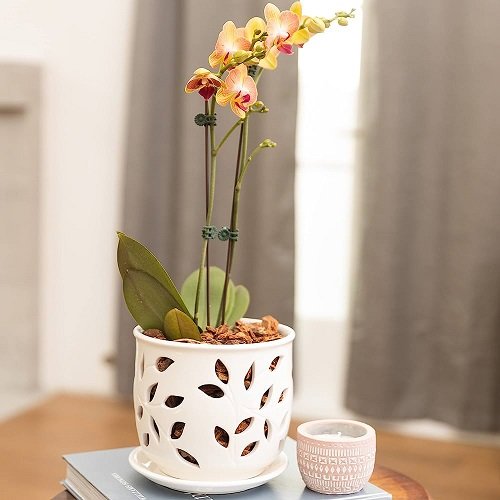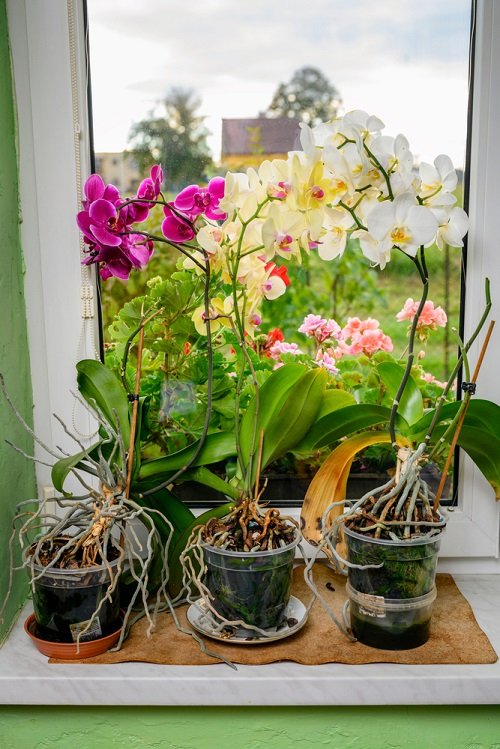Orchid Pot Holes – Are they important? Do you need to look for them before choosing a container? Let’s get all the details!

When it comes to plant care, Orchid Pot Holes can play a vital role in their overall development and flowering. In this article, we will discuss the crucial points along with How to Pick the Perfect Orchid Pot.
Check out DIY Orchid Potting Mix Recipes here
Orchid Growth Habit
Most orchids in their natural environments are epiphytes, meaning they cling to tree trunks or branches. They gather moisture and nutrients from the air, rain, and debris around their root zones.
In the jungle, you can find a Phalaenopsis orchid growing on a tree branch, with its roots exposed to air movement, rain, and humidity. The ideal orchid pots recreate these moist yet well-drained conditions while ensuring good airflow for the roots.
Check the Use Lemon Juice for Orchids & These 7 Miracles will Happen here
Orchid Pot Holes
Orchids, particularly the popular Phalaenopsis (moth orchid), are known for their unique root system that requires plenty of air circulation to remain healthy. Because orchids in the wild often grow in the forks of trees, their roots are accustomed to receiving plenty of air and excellent drainage.
When potting orchids at home, it’s essential to provide them with a similar environment. Hence, the design and setup of your orchid pot play a key role in maintaining the health of your orchid.
When it comes to Orchid Pot Holes, here are some things you need to consider:
1. Number of Holes
Orchid pots often have more holes than standard pots. They may have holes not just on the bottom, but also on the sides. This improves aeration and ensures the roots don’t sit in water, which could lead to root rot.
2. Size of the Holes
The size of the holes is also important. Larger holes provide more aeration but could let orchid potting mix escape.
If the holes in your pot are large, you might consider lining the pot with a piece of mesh or coffee filter to keep the potting mix in while still allowing water to drain and air to circulate.
Check out the best tricks to make orchids re-bloom here
How to Pick the Perfect Orchid Pot
Choosing the right pot for your orchid can significantly impact its growth and overall health. Here are some factors to consider when picking the perfect orchid pot:
1. Material
Orchid pots can be made from various materials, including plastic, ceramic, clay, and glass. Each material has its benefits.
- Plastic Pots: These are lightweight, cheap, and retain moisture well. Clear plastic pots also allow light to reach the roots and enable you to see the root health without removing the plant from the pot.
- Ceramic Pots: These pots, particularly unglazed ones, are excellent for aeration as they are breathable. They can be a good choice for orchids like Dendrobiums and Cattleyas that prefer to dry out a bit between waterings. Ceramic pots are also more stable and less likely to tip over due to the weight of the plant.
- Clay Pots: Similar to ceramic, clay pots are breathable and can provide good aeration. They’re heavier and can provide stability for larger orchids.
- Glass Pots: These are typically used for water culture orchid growing. They allow light to reach the roots and create a high humidity environment.
2. Size
The pot size should be just large enough to accommodate the orchid’s roots. Orchids generally prefer to be root-bound rather than placed in an oversized pot.
A pot too large can hold excess moisture leading to root rot. A good rule of thumb is to choose a pot that is 1-2 inches larger in diameter than the current one.
Here are Plant Pot Sizes Inches to Gallon
3. Shape
Most orchids do well in standard round pots. However, some types of orchids like Cymbidiums that have a spreading growth habit might benefit from a wider, shallower pot.
4. Weight
The weight of the pot can affect its stability. If you have a tall or top-heavy orchid, a heavier pot, like one made of ceramic or clay, can provide better stability and prevent the pot from tipping over.
Have a look at the rarest orchids here
5. Color
Light-colored pots reflect sunlight and can help keep the root zone cooler in hot climates. In contrast, dark pots absorb more heat, which can be beneficial in cooler climates.
6. Orchid Type
Different types of orchids have different cultural needs, which can influence the type of pot you should choose.
- Phalaenopsis: They do well in clear plastic pots as their roots perform photosynthesis.
- Dendrobiums, Cattleyas, and Oncidiums: These prefer to dry out a bit between waterings, making breathable pots like unglazed ceramic or clay a good choice.
- Paphiopedilums and Phragmipediums: These prefer constant moisture, so plastic or glazed ceramic pots might be a better fit.




